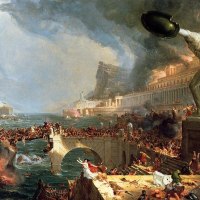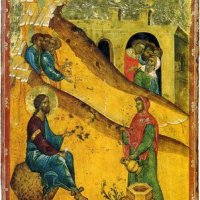 7.1 The Date (of the prophet’s ministry and work)
7.1 The Date (of the prophet’s ministry and work)
Micah was a contemporary prophet of Isaiah. The superscription in Micah 1:1 dates his ministry during the reigns of the Judahic kings Jotham, Ahaz, and Hezekiah. Wood calculates that since Uzziah is not listed among the kings, “he evidently started his ministry a little later than Isaiah, and because he mentions nothing concerning the invasion of Sennacherib in the day of Hezekiah he probably ceased earlier.”[84] The years 735-710 B.C. seem likely for his ministry.
Although critical scholars have questioned these dates, further biblical evidence argues for the likelihood of a late eighth century dating.[85] Jeremiah 26:18-19 demonstrates that Micah prophesied during Hezekiah’s reign and also quotes Micah 3:12. His prediction of Samaria’s fall in 1:2-6 proves that he ministered prior to the fall of Samaria in 722 B.C. In 5:10, the mention of horses and chariots of Judah implies a period of prosperity, which well describes the years of Jotham’s rule after Uzziah.
7.2 Background History (historical setting of the prophet)
Micah’s work fell entirely within the prophetic ministry of Isaiah, and because they ministered to the same audience (the southern kingdom of Judah), the background history is the same as that of Isaiah. Since Micah’s career was relatively brief compared to Isaiah’s long and distinguished ministry, he did not share the experience of Sennacherib’s invasion. However, Micah was not a stranger to Assyrian assaults as he lived during the vicious attacks on Judah’s northern neighbor, Israel. The fall of Israel and the subsequent exile certainly “affected his ministry just as it did that of Isaiah.”[86] Van Gemeren notes that
with the fall of Samaria the Israelites fled for asylum to Judah, and we may deduce from the archaeological record of Jerusalem that the city increased rapidly up to four times its previous size. Her leaders grew more corrupt (3:9-12), and the moral fiber further disintegrated (7:1-6).[87]
Although Assyria was the primary threat to Judah during the days of Micah, he looked to the future and prophesied of “the destruction of Judah at the hands of the Babylonians, which took place in 586 B.C., and even further ahead to the restoration from captivity [in 539].”[88]
7.3 Work and Person (character and ministry of the prophet)
Micah identifies his home town of Moresheth (1:1), which is probably the same as the Moresheth-gath cited in 1:14. This rural village was located in a valley approximately 20 miles southwest of Jerusalem. Since Micah is only mentioned in one other book (Jer. 26:18-19), we must glean from the few clues in his book to deduce personal characteristics. Micah was raised in a small rural village, therefore Wood concludes he had close contact with poor people, which contributed to his obvious concern for their plight. His words reveal he was well acquainted with international affairs, especially those of Israel. Wood suggests Micah may have acquired this knowledge as a result of Moresheth’s proximity to an international caravan route running north-south. Furthermore, Moresheth was located only 20 miles from Tekoa, so it is possible Micah may have had contact with and been influenced by the elderly prophet Amos (who had ministered at Bethel only 25 years earlier). Micah was an influential prophetic voice in Jerusalem, as evidenced by another prophet (Jeremiah) mentioning his name a century later (this is a rare occurrence in the prophetic corpus). He certainly would have prophesied against the false prophets of the city and the moral laxity of the people.
Micah was “fully aware of what was happening to Israel in the north, where destruction was already being experienced, and [he] used that illustration to impress Judah that the same could well happen to her.”[89] His ministry supported the far-reaching religious reforms of Hezekiah. No doubt the prophetic critiques offered by Micah (and Isaiah) influenced King Hezekiah to restore the sole worship of Yahweh in the land. Van Gemeren draws attention to the lasting significance of Micah and his message.
A century later Micah’s ministry was still remembered by some of the elders of Judah. They reminded King Jehoiakim that King Hezekiah had left Micah unharmed, even though he, like Jeremiah, had proclaimed the destruction of Jerusalem. Because of this remembrance of Micah, Jeremiah escaped death (Jer. 26:17-24).[90]
7.4 The Book (abbreviated outline[91] and brief summary)
I. The heading (1:1)
II. First series of prophecies: God gathers the elect remnant into Jerusalem (1:2-2:13)
A. God punishes Samaria and Judah (1:2-16)
B. Woe to the oppressors (2:1-11)
C. God preserves a remnant in Zion (2:12-13)
III. Second series of prophecies: God restores Jerusalem’s former dominion to the purified remnant (3:1-5:15)
A. Old Jerusalem and its corrupt leaders fall (3:1-12)
B. New Jerusalem exalted over the nations (4:1-8)
C. Zion’s present pangs will give birth to a new era (4:9-13)
D. The birth and exaltation of the Messiah (5:1-6)
E. The remnant rules the nations (5:7-9)
F. God protects his purified kingdom (5:10-15)
IV. Third series of prophecies: God forgives the remnant of his sinful people (6:1-7:20)
A. Israel accused of breaking covenant (6:1-8)
B. The covenant curses fulfilled on Jerusalem (6:9-16)
C. Jerusalem’s social structures break apart (7:1-7)
D. Victory song: Who is like the remnant’s pardoning God? (7:8-20)
The 19 oracles of Micah are arranged in a tri-cyclical pattern (chapters 1-2; 3-5; 6-7). Each cycle begins with the theme of judgment and ends on a salvific refrain. Micah predicts judgment for Judah because they had broken the terms of the covenant they entered with the Lord. God had redeemed his people from Egypt, but they had not remained faithful to the Mosaic Covenant stipulations. Thus “the Lord now brings his covenant-based lawsuit against them, calling on the earth and its peoples as witnesses (1:2; 6:1-2); (see also Deut. 4:26; 30:19; 31:28; 32:1).”[92] Their only hope for restoration is the Lord’s covenant promise to the patriarchs. “You will give truth to Jacob, and mercy to Abraham, which You have sworn to our fathers from days of old” (7:20). The Lord revealed to Micah that restoration would occur in the remnant, which is the key to understanding the prophecy of Micah. The promised (Davidic) ruler from the tribe of Judah will hail from Bethlehem and be none other than the Christ (5:2), “whose goings forth are from of old, from everlasting.” Following the devastation of Israel and Judah, the restoration will manifest itself in a small but purified remnant that will constitute the re-gathering of dispersed Israel (2:12; 4:6; 5:3). This remnant will be blessed with the glorious, promised covenant inheritance.
Once reestablished, this remnant shall multiply and flourish as they come to possess the wealth of the nations in the name of the Covenant LORD, and as the nations flow to the mountain of the Lord (2:12; 4:13c; 4:1-3). As the kingdom is restored, so the king will be restored, and paradise will be renewed. As Bethlehem was the birthplace of great King David, so Bethlehem will be the home of the greater than David, even though his origins have been from eternity (4:8; 2:13; 5:2-4).[93]
Micah instructs God’s chosen people today in how to live in light of the restoration they currently have and will eventually receive at the hand of the Covenant LORD. In light of their promised salvation, they respond, “for all people walk each in the name of his god, but we will walk in the name of the LORD our God forever and ever” (4:5). Furthermore, they are to depend and trust in God’s sovereign grace (5:9), not the works of their own hands (5:10-15). Those saved by grace can be confident in trials today and tomorrow because God will be faithful to his covenant promises (7:18-20).
Endnotes
84. Wood, Prophets of Israel, p. 309.
85. Citations of biblical evidence in this paragraph are from Wood, Prophets of Israel, pp. 309-10.
86. Wood, Prophets of Israel, p. 310.
87. Van Gemeren, Interpreting the Prophetic Word, p. 150.
88. Dillard and Longman, Introduction to the Old Testament, p. 399.
89. Wood, Prophets of Israel, p. 311.
90. Van Gemeren, Interpreting the Prophetic Word, p. 150.
91. Bruce Waltke, “Micah,” in New Bible Commentary, 21st Century ed. (Downers Grove, IL: InterVarsity Press, 1994), p. 823.
92. Robertson, Christ of the Covenants, p. 211.
93. Ibid., pp. 211-12.













